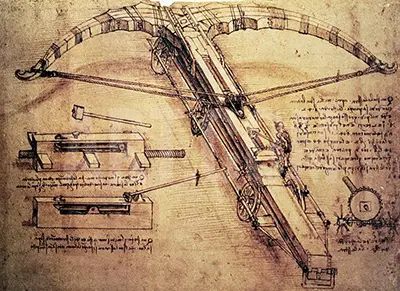His sketch of a catapult was created using pen and ink on paper, and the sketch itself is accompanied with explanatory notes in Da Vinci's own unmistakable hand. It is clear that, though it is very beautiful to look at, this was a drawing that was designed to be put to use.
As well as a work of art, it is a functional sketch for a catapult.
Da Vinci lived between 1459 and 1519 and throughout his life he applied the same skill to observe the world around him minutely and carefully no matter what he was doing. These minute observations bore fruit in his sketches for inventions just as much as in his paintings.
And, in the drawing of a catapult under discussion here, these two elements - art and invention - come together. Though his most famous painting is probably the Mona Lisa, his small sketches are definitely worth some study.
It is clear from this drawing that Da Vinci intended his device to work using levers, cogs and weights. It was designed to be made form wood, perhaps with the addition of some metal elements, and to fling rocks over a long distance.
Though he may just have thought up this invention for fun, Da Vinci's catapult has clear military implications and this artist's interest in warfare has made some people uneasy - should not art be a purely peaceful occupation?
No matter how it is interpreted, the use of strong and determined ink lines and swift, straight lines of ink for shading, are characteristic of Da Vinci's style of drawing. Da Vinci drew many different sketches for catapults, and each of these sketches has slightly different characteristics.
It is clear that the catapult was a theme that kept on occurring to his mind throughout his life. And, he used his drawings to jot down his thoughts and to refine and hone his ideas for better machinery. Fellow Renaissance master, Michelangelo, used produced many designs for inventions himself.
With the catapult drawing series, then, it can be said that we see the wonderful mind of Leonardo Da Vinci in action.


